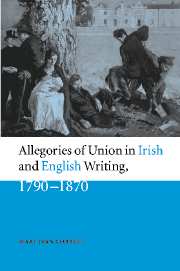 Allegories of Union in Irish and English Writing, 1790–1870
Allegories of Union in Irish and English Writing, 1790–1870 Book contents
- Frontmatter
- Contents
- Acknowledgments
- Introduction
- Chapter One Public affections and familial politics: Burke, Edgeworth, and Ireland in the 1790s
- Chapter Two Allegories of prescription: engendering Union in Owenson and Edgeworth
- Chapter Three Troubling others: representing the immigrant Irish in urban England around mid-century
- Chapter Four Plotting colonial authority: Trollope's Ireland, 1845–1860
- Chapter Five England's opportunity, England's character: Arnold, Mill, and the Union in the 1860s
- Afterword
- Notes
- Bibliography
- Index
Afterword
Published online by Cambridge University Press: 22 September 2009
- Frontmatter
- Contents
- Acknowledgments
- Introduction
- Chapter One Public affections and familial politics: Burke, Edgeworth, and Ireland in the 1790s
- Chapter Two Allegories of prescription: engendering Union in Owenson and Edgeworth
- Chapter Three Troubling others: representing the immigrant Irish in urban England around mid-century
- Chapter Four Plotting colonial authority: Trollope's Ireland, 1845–1860
- Chapter Five England's opportunity, England's character: Arnold, Mill, and the Union in the 1860s
- Afterword
- Notes
- Bibliography
- Index
Summary
… we should not imagine that the world presents us with a legible face, leaving us merely to decipher it; it does not work hand in glove with what we already know; there is no prediscursive fate disposing the word in our favour. We must conceive discourse as a Violence we do to things …
In the works selected for consideration in this study, I have chosen to read the making or breaking of domestic unions as, in part, allegorical figures for a colonial relation. Whether they appear in fictional or non-fictional writing, tropes and plots associated with the private sphere that enact familial intimacies do at least double duty, in that they “negotiate the figured distance between their fictional status and what we call history,” as Theresa M. Kelley characterizes the work of allegory, operating “as though the barrier between reality or history and abstraction were a porous membrane instead of a guarded wall that protects what is true from what is not.” My practice as a reader of these tropes and plots has been to tease out their analogical implications, to read back and forth across the barriers or borders between historical fictions and fictive histories, perhaps because the critical and theoretical frames that underpin my work are themselves covertly allegorical.
- Type
- Chapter
- Information
- Allegories of Union in Irish and English Writing, 1790–1870Politics, History, and the Family from Edgeworth to Arnold, pp. 182 - 185Publisher: Cambridge University PressPrint publication year: 2000
